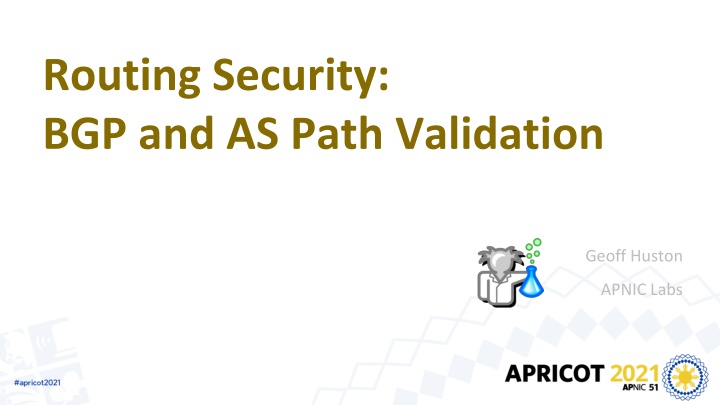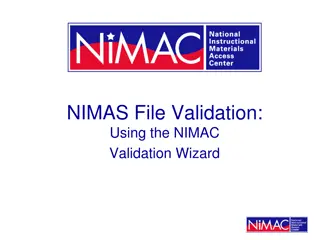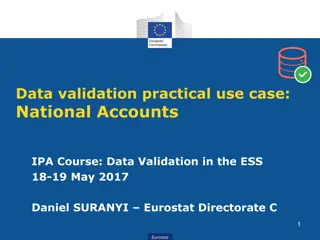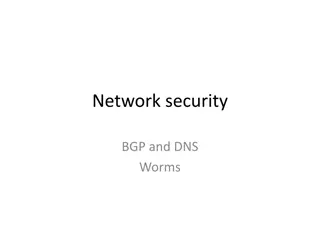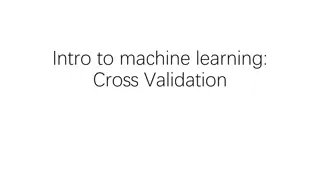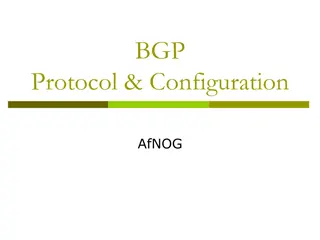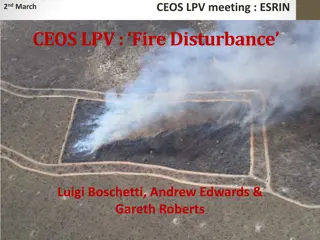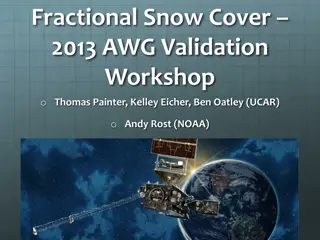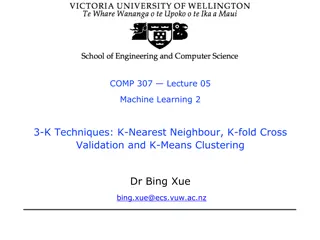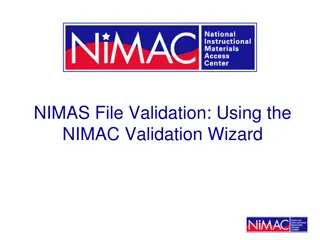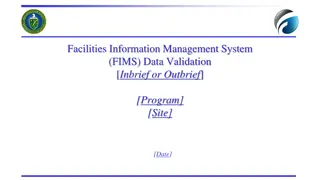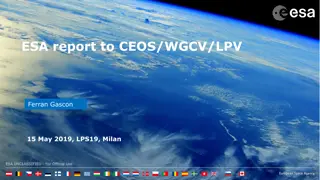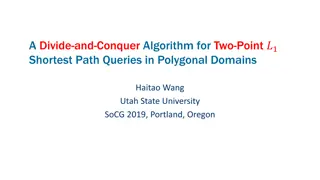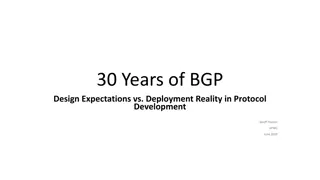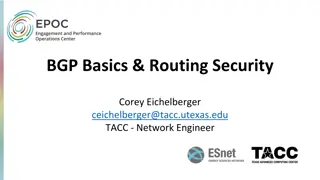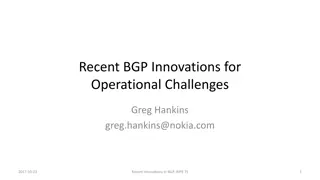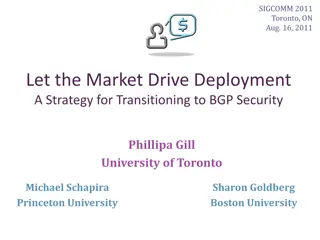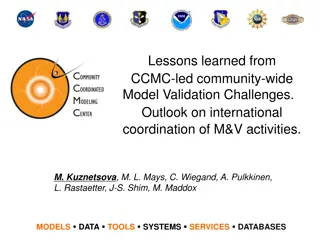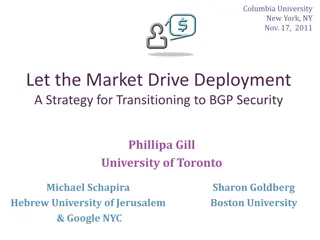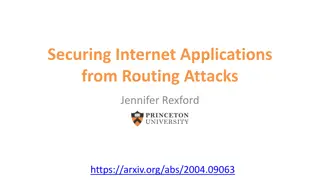BGP and AS Path Validation
This content delves into the intricacies of BGP and AS Path validation, discussing topics such as AS Path manipulation, route selection processes in BGP, protecting the AS Path attribute, and BGPSEC for AS Path protection. It explores scenarios where ROA validation may not suffice and highlights the importance of validating AS paths in BGP routing. Through insights from Geoff Huston of APNIC Labs, it sheds light on the complexities involved in ensuring the security and integrity of BGP routing.
Download Presentation

Please find below an Image/Link to download the presentation.
The content on the website is provided AS IS for your information and personal use only. It may not be sold, licensed, or shared on other websites without obtaining consent from the author.If you encounter any issues during the download, it is possible that the publisher has removed the file from their server.
You are allowed to download the files provided on this website for personal or commercial use, subject to the condition that they are used lawfully. All files are the property of their respective owners.
The content on the website is provided AS IS for your information and personal use only. It may not be sold, licensed, or shared on other websites without obtaining consent from the author.
E N D
Presentation Transcript
Routing Security: BGP and AS Path Validation Geoff Huston APNIC Labs
When ROA Validation is not enough 192.0.2.0/24 192.0.2.0/24 ASPath 2,1 192.0.2.0/24 ASPath 4,3,2,1 AS1 AS3 ROA 192.0.2.0/24 OriginAS 1 192.0.2.0/24 ASPath 3,2,1 AS5 AS4 AS2 192.0.2.0/24 ASPath 4,666,1 192.0.2.0/24 ASPath 666,1 AS 5 accepts this fake route as the Origin AS 1 Is matched by a ROA and the fake AS Path is shorter 192.0.2.0/24 ASPath 1 192.0.2.0/24 ASPath 1 AS666 AS 666 synthesises a path to 192.0.2.0/24 Using origin AS 1
BGP and AS Path In BGP each eBGP speaker prepends it s own AS to the AS_PATH attribute of a BGP UPDATE message The AS Path is used in BGP loop detection as received updates that contain the local AS number in the AS Path are rejected The AS Path is used in BGP route selection process where shorter AS paths are preferred over longer paths, modulo other local BGP route preference settings
AS Path Meddling Manipulation of AS Paths can be used to: Manipulate third party s route selection by denial (AS poisoning ) Bias third party s route selection by AS Path trimming or AS Path bloating As long as the original Origin AS is left in the altered AS Path then simple ROV filtering will not detect this manipulation
Protecting the AS Path Attribute The AS Path is* a snail trail of a route s object s propagation through the eBGP fabric We can use this characteristic to create a digital signature train that allows a validator to confirm that the AS Path faithfully represents the AS propagation chain through the eBGP inter-AS topology * That s mostly true, but not always, and it can be an important distinction!
BGPSEC and AS Path Protection Each eBGP speaker has a private key that is associated with the local AS, certified within the RPKI framework When an update is passed to an eBGP peer the local BGP speaker takes the Path signature block, and adds the AS of the eBGP peer and signs this couplet with its own AS key. AS3 AS4 AS5 192.0.2.0/24 AS2 Signed AS1 Signed AS2 Signed AS3 Signed AS4
BGPSEC and AS Path Protection The AS Path is now tightly tied to the route object propagation path Attempts to manipulate this AS Path are now readily detectable
BGPSEC and AS Path Protection BUT: Piecemeal partial deployment is not supported protection is only afforded within islands of comprehensive deployment Routers need to hold private keys and perform signing functions Validating AS Path signature attributes can be computationally expensive as detached filter list validation model used in the Route Origin Validation implementation is not applicable to this form of Path validation Protocol Correctness is not Policy Correctness certain forms of route leaks are not readily detected in this framework BGPSEC is highly unlikely to be deployed in the mainstream of the Internet s eBGP space
Other Approaches? Do nothing and rely on Origin Validation? But Origin Validation is not enough There are differing views as to how much this not enough is deficient. Some have made the case that a few basic assumptions about eBGP topology (PEER LOCK) and origin validation restricts the space of plausible synthetic AS Path constructs so as to make not enough more likely to be good enough . Others (including me!) have made that case that Origin Validation without some reasonably robust AS Path protection is about as useful as wearing an armour plating made of wet lettuce leaves! Are there other approaches somewhere between do nothing and BGPSEC?
Cue: soBGP Secure Origin BGP was proposed to the IETF back in 2003 AS Path Plausibility Each participating AS publishes a list of all its AS neighbours, signed by the local AS AS1 connected to: AS2, signed AS1 AS2 connected to: AS1, AS3, signed AS2 AS3 connected to: AS2, AS4, signed AS3 AS4 connected to: AS3, AS5, signed AS4
AS1 connected to: AS2, signed AS1 soBGP Example AS2 connected to: AS1, AS3, signed AS2 AS3 connected to: AS2, AS4, signed AS3 AS4 connected to: AS3, AS5, AS666, signed AS4 192.0.2.0/24 192.0.2.0/24 ASPath 2,1 192.0.2.0/24 ASPath 4,3,2,1 AS1 AS3 192.0.2.0/24 ASPath 3,2,1 AS5 AS4 AS2 192.0.2.0/24 ASPath 666,1 But AS 1 is not connected to AS 666! 192.0.2.0/24 ASPath 1 192.0.2.0/24 ASPath 1 AS666 AS 666 synthesises a path to 192.0.2.0/24 Using origin AS 1
soBGP Lightweight process Allows off-router processing and detached filter management Allows for piecemeal partial validation (if you lie about me in an AS Path then you have to include one of my AS neighbours)
soBGP BUT: No policy component route leaks are not detected in soBGP Replaces Path Validation with Path Plausibility The extent to which AS Path manipulation can pass undetected depends on the uptake of AS adjacency publication
Routing: Path + Policy Each network has routes learned from Customers, Peers and Providers Routes learned from customers are advertised to all other Customers, all Peers and all Providers Routes learned from Peers are advertised only to all Customers Routes learned from Providers are advertised only to Customers
Valley Free Routing Provider Peer Peer Customer Every AS Path is a vector through the inter-AS topology Every policy-compliant AS path is a sequence of >= 0 Customer to Provider links <= 1 Peer to Peer link >= 0 Provider to Customer links
Valley Free Routing 192.0.2.0/24 ASPath 2,1 192.0.2.0/24 ASPath 3,2,1 AS4 AS3 Provider Peer Peer Customer Provider Provider Provider AS2 192.0.2.0/24 ASPath 4,3,2,1 Customer Provider Customer Customer 192.0.2.0/24 ASPath 1 Customer AS5 AS6 AS1 192.0.2.0/24 If AS 6 leaks a route learned from AS 3 to AS 4 then it is creating a valley in the path 4, 6, 3, 2, 1. Valley Free routing in AS4 could detect this leak if we knew this customer/provider relationship
ASPA = sparse soBGP + Valley Free Each participating AS lists all of its authorised provider ASs and signs this list in an AS Provider Attestation (ASPA) object Similar to a ROA, its an authority to propagate a route learned from an AS, issued by that authorizing AS
ASPA = sparse soBGP + Valley Free In a comprehensive deployment model every AS Path has the sequence of: >= 0 Customer-to-Provider (ASPA forward ) <= 1 Peer-to-Peer (no ASPA) >= 0 Provider-to-Customer (ASPA backward ) In a partial deployment model an AS Path partially matches some forward ASPAs and then some backward ASPAs any other ordering represents a policy violation!
ASPA Example AS4 AS3 Provider AS1: Providers: AS2 Peer Peer Customer Provider Provider Provider AS2: Providers: AS3 AS2 AS6: Providers: AS3, AS4 Provider Customer Customer Customer Customer AS5: Providers: AS4 AS5 AS6 AS1 192.0.2.0/24
ASPA Example 4 to 6 is a down provider to customer 6 to 3 is an up customer to provider 4 to 6 to 3 is a valley AS Path: 4 6 3 AS4 AS3 Provider AS1: Providers: AS2 Peer Peer Customer Provider Provider Provider AS2: Providers: AS3 AS2 AS6: Providers: AS3, AS4 Provider Customer Customer Customer Customer AS5: Providers: AS4 AS5 AS6 AS1 192.0.2.0/24
ASPA Lightweight process Allows off-router processing and detached filter management Allows for piecemeal partial AS Path validation Some/most route leaks are detectable if there are related ASPA attestations If a ASPA AS leaks then the path will contain a down then an up AS path
ASPA BUT: Like soBGP, ASPA replaces Path Validation with Path Plausibility The extent to which AS Path manipulation can pass undetected depends on the uptake of ASPA publication
ASPA Status Internet Draft: https://tools.ietf.org/html/draft-ietf-sidrops-aspa-profile-04 Alexander Azimov, Qrator Labs Likely to be published as an RFC (at some time in a vague and indefinite future!) ASPA filtering Operational Model yet to be defined Is this another case of a split model where a processing engine sends updates to an AS Path filter maintained on eBGP speakers in a manner similar to ROA Validation? Or are the semantics of the ASPA validation process not readily mapped into filter rules and instead do they need to handling incoming AS Paths through onboard processing?
